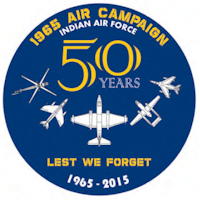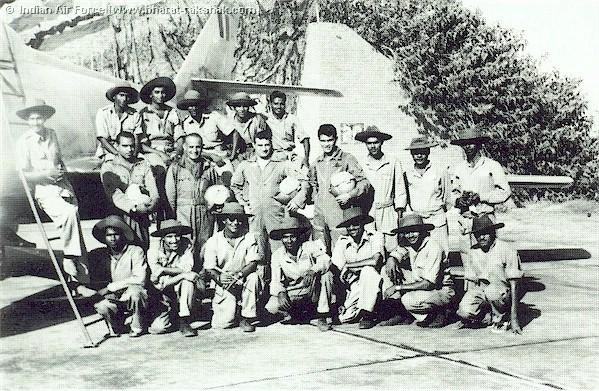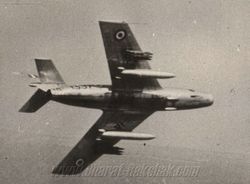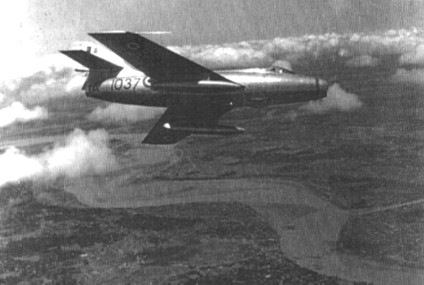Wing Commander Chandrakant Nijanand Bal was a young pilot with No.31 Squadron flying the french Mystere IVa fighter bomber during the 1965 war. The Squadron, under Wg Cdr Jimmy Goodman, distinguished itself operating from Pathankot.
 Wing Commander Chandrakant Nijanand Bal was a young pilot with No.31 Squadron flying the french Mystere IVa fighter bomber during the 1965 war. The Squadron, under Wg Cdr Jimmy Goodman, distinguished itself operating from Pathankot.
Wing Commander Chandrakant Nijanand Bal was a young pilot with No.31 Squadron flying the french Mystere IVa fighter bomber during the 1965 war. The Squadron, under Wg Cdr Jimmy Goodman, distinguished itself operating from Pathankot.
The first shots
It was the 1st of September 1965. Time 1730 hrs. Some twenty odd faces could be seen in the briefing room. The Officer-in-charge flying, entered the room and closed the door behind him. He paused, head cocked to one side in his usual fashion. “Boys, we have got the green light. The Pak army, with some 90 tanks crossed the border this morning in the Chhamb Sector” and he indicated a small bulge on the quarter inch map. “Your job is to stop them. The Ground Liaison Officer will take over from now.” The GLO completed his briefing and the pilots took down the details on their maps and hurried to their respective squadrons.
I had been recalled from leave some days ago. I had just spent about three weeks at home. The daily newspaper used to bring news of ‘kills’ by our security forces. One could feel the mounting tension. I reached my squadron on the 27th of August. Sethi was the first to meet me. “You missed some sorties over the valley while on leave” he said. I knew he meant the Srinagar Valley. I was looking forward to some good flying. However, things worked out differently. Flying was stopped and the airmen worked feverishly to get the maximum number of aircraft on the flight line. The Navigation Officer of the Squadron was burdened with the number of maps being issued. We were giving the final touch to the ‘cutting edge.’
Early morning, 1st September. I was standing by for a patrol sortie in the Valley. I listened to the briefing, inwardly wishing I were in the formation. The sortie went off without a hitch. Its 10 O’clock and Tony passes the word that Gurdaspur has been shelled. We celebrated our Squadron’s second anniversary by a special lunch. There is a cake for the occasion baked by Mrs Boss and we made short work of the ceremony. 5 o’clock and the word goes around. I leapt to my feet and made it towards the briefing room. Tony reminded me that I have forgotten my map. I ran back and fetched it, not wishing to miss any part of the briefing.
I was once again standing by for the first section, and felt bad about it. It must have shown on my face for Tony said that I could join the second section. I went to my aircraft well before time and inspected it. Under each wing is a pod containing rockets. I had never fired this before and mentally go through the briefing, “Circuit breaker IN, Wing Master ON, lift flap and press.” I was pleased with myself. I now saw the first section of Vampires getting airborne. It was time to strap-up. My section took off and I switched off the engine. Peachy came on my scooter and asked me to hop on. I am to fly another aircraft. I strap-up for the second time. Just as I started the engine Tony came running to my aircraft. He was supposed to be in the first section but I did not think of that then. He signaled me to get out. Something must have gone wrong. I did as I was told and cursed, and went back fuming to the Squadron. I must have looked a sight.
That day 28 sorties were flown. That must have been a good blow to the advancing tanks, for their progress was slowed down. We lost Horsey Bharadwaj that day. News of three others was yet to come.
I started the next day early. The duty bearer woke me up at 3 o’clock. I dressed quickly and reported to my Commanding Officer (Wing Commander WM Goodman) in the Mess, as instructed. Both the Station Commander and he had been busy during the night. I could see that plainly as fatigue is quite visible on their faces. The Station Commander explained the situation to me. I am to go with the Boss to Chhamb at first light for a reconnaissance of yesterday’s battlefield. We are to have escorts for our protection. A final briefing and a time check and we were off to our aircraft. We took off at dawn and made for the target area, flying low, just above the trees to avoid enemy radar detection. As we neared Chhamb I spotted four Sabres but kept quiet, as there was no immediate danger.
The Sabres were orbiting the battle area. A quick check on the sabres and we started our reconnaissance ‘literally under their noses.’ The enemy aircraft had not yet seen us and Boss called “Buster port” and all of us veered sharply to the left and opened up power. We are now on our way back. After reaching base, I climbed out of the cockpit soaked in sweat, I breathed in the cool morning air and felt good. A few words of praise to the airmen and I was on my way for the debriefing. I met Sethi after the debriefing. He had flown yesterday and got a tank. He asksed how the mission had gone and I narrated the tale.
The next three days saw little other activity except more strikes in the Chhamb Sector. Every day the scores went up a little. We were hitting anything on wheels. Even a few camps were detected and fired upon. These especially, were very difficult o see from the air as they were well camouflaged.
Lahore front opens
On the 6th of September we woke to the sound of artillery guns. The western horizon was aglow and we were informed about the advances being made by our ground forces in the various sectors. The very same evening Pak Sabres visited our Base with unfriendly intentions.
We were all sitting outside our crew room talking shop. One of our missions was seen returning. For a few moments’ aircraft were seen all over the circuit and they landed one behind the other. We were about to resume our discussions when Tony spots an unfamiliar looking aircraft rolling into a dive. “Here they come” he said and strided into the crew room. There in a little confusion and bodies colliding with one another as an effort was made to head for protection. I ran for a trench, tripped over, fell, scrambled on all fours and finally dived into it. This is done to the tune of machine gun fire from the Sabres.
Others later remarked that this reminded them of a scene from the film ‘From here to Eternity.’ A moment later I felt a heavy weight crushing my legs. Looking back I saw Chandru who sheepishly said, “I hope your leg is not hurting.” Roundy, the Squadron’s only pilot attack instructor was coolly assessing the Sabre tactics and score, sometimes saying with a frown “That’s not how it should be done.” After the raid was over we trickled out of hiding, all dusty, but with false smiles on our faces.
Back after our days work I was in the bath and have just about soaped myself when I heard the anti-aircraft guns firing. I grabbed a towel and was in a trench in no time. It turns out to be a false alarm and a kind soul gives me a handkerchief to wipe the soap out of my eyes. The soapy episode was followed the same night by the first night raid of the war. Though it stood nowhere when compared with the London or Berlin air raids of the last war, it still qualified to be classed as an air raid by virtue of the fact that a bomb fell a little to one side of the runway, causing a high degree of excitement among us. Those still clinging to the bar by candle light managed to reach the nearest trench, not forgetting to bring their glasses with them. The sky filled with red fireballs, which indicated the individual lines-of-fire of the anti-aircraft guns. In the dim light of a rising quarter moon we had a glimpse of the B-57. The raid did no damage other than disturb our sleep. This practice was to follow in all future night raids. During one such night we were disturbed three times within an hour or two in between. These raids demonstrated the unique human quality of adaptation. Never did anyone feel that this was his last day in spite of heavy odds against him. We used to sleep with one ear tuned to the siren and could sprint to the trenches in total darkness id called to do so.
The war had been going on for over a week now. The army was fighting a determined enemy on the ground while the sir force battled for air superiority. Many a pilot made a ‘Nylon descent’ to safety or captivity. In this grim struggle one of our tasks was to find out what was going on behind the enemy lines. On one such mission the pilots returned and excitedly reported seeing a railway train carrying a load of tanks. This vital information was used later in an extremely successful strike on the train thus denying to the enemy these tanks at a critical time.
On the 10th of September we came to know that our Boss had been awarded the Maha Vir Chakra ‘for gallantry in the face of the enemy.’ We were all proud of him and there was much rejoicing. He in turn had taken the news with utmost modesty, reminding us of the unfinished task ahead of us. We felt all the more glad for it indicated that we were as a unit an efficient fighting force.
 |
| Aircrew and groundcrew personnel of No.31 Squadron at Pathankot with a Mystere IVa . CO Wg Cdr W M Goodman MVC is standing 2nd from left. Squadron Leader Tony Mousinho and Flying Officer M McMahon to his right. |
One morning I was No 2 in a four aircraft formation with Tony as the leader, Roundy and Sethi forming the sub-section. The task was to destroy a concentration of tanks in the Chawinda Sector. We took-off in the dark and in first light of dawn joined up into battle formation. At the appointed time we descended from a comfortable 500 ft to 200 ft above ground level and set course for the target area. Strict radio silence was maintained and as we go deeper into enemy territory the height was reduced to one just above the treetops. I heard Tony calling “Pull up.” I did the same and was surprised to see the ‘pull up point’ some five miles ahead. I saw the leader make a frantic effort to get ‘down to the deck’ as I banked right, kicked a rudder and forced the aircraft to keep in formation. In the mean time the enemy tanks having seen us, fired some anti-aircraft shells and the black puffs betrayed their position, which we had not seen earlier. But this took some time to register. On seeing the puffs Sethi called “Bogey 2 o’clock high.” After some moments the leader was heard saying “that is the ack-ack. Pulling up for the attack.”
The tanks (which were apparently in harbour) on seeing us diving like hawks made a desperate bid to spread out but were too slow to escape our fire. They were so closely spaced that I was unable to fire as the leader is in my ‘sights.’ The formation pulled up after the dive and turned left for a second one. Sethi’s voice filled my earphones “Got two of them.” As I roll in for the attack all I saw was a cloud of dust. I fired in the centre, and claimed a probable. Some months later I met an Army officer, who said that on the morning he, in his tank, was scouting when he saw four aircraft attacking some ground target in the distance. He reported seeing six columns of smoke after the attack.
 Mystere IA1337 in flight – equipped with two drop tanks and T-10 rockets under the wings Mystere IA1337 in flight – equipped with two drop tanks and T-10 rockets under the wings |
Belly Landing
13th of September, my 13th sortie for the month, and the luck of the number all go together to produce a memorable flight. Once again I was No 2, with Chandru as leader, Sandy and Sethi forming the sub-section. The mission called for a reconnaissance deep inside enemy lines. The sortie went off well, in fact too well to be true. We did not see any enemy activity on the ground or in the air. At the last turning point we spotted some trucks and they are despatched with quickly. It is at this most vulnerable moment that we lost Sethi. Speculations to this day are that he either got shot down by ground fire or went down to the guns of a dare-devil sabre pilot. In my attack I suddenly felt the aircraft being hit three times. The aircraft shuddered and the instrument panel vibrated on its mountings. A quick check of the engine instruments – indicating a sound engine. A similar check on the flight controls and I knew the aircraft is still airworthy. Keeping in mind to find the damage later I concentrated on getting back in the formation. As we raced back towards the base, Sethi’s absence was noticed. We all in turn called him on the radio, but there was no answer.
I discovered that I did not have any hydraulic pressure, which meant that the undercarriage will have to be lowered by the emergency method. I informed the leader who adviced me to maintain the present speed until we reach base. Over base I make another discovery – the undercarriage was not coming down at all! I informed the control tower of my emergency situation and my intention of burning up excess fuel prior to a belly landing. Within 10 minutes Tony comes in clearly “Everything is OK. The runway is being cleared for you.” He then went through the procedure of landing with wheels up with me to ensure I have not forgotten anything. With the fuel level at a safe low I made an approach but overshot the runway. Correcting my fault I tried again and called out “Am making it this time.” Finally committing myself no going back – I braced for the landing.
Over the edge of the runway the power was reduced to idle and the hood opened. I first felt a bump, then a continuous grinding sound as the aircraft slid on its belly. The aircraft (IA1037) came to a halt in what seemed to be eternity and I quickly un-strapped and ran a good distance away. I met with a grinning CO. The doctor is also there wondering how he should go about it for he expected a stretcher case. Wheeling me off for a check-up, he explained “Regulations”
 |
| Mystere IA1037 seen in flight in better times. This very aircraft was damaged by AA and had to land on its belly on 13th September 1965. |
The war had developed for quite some time now. Those of us, who had lost their appetite during the first week, were making an effort to eat well again. We had become an efficient team, aimed at causing maximum destruction to the enemy. We did not however develop any feelings of hatred. Aviators are said to be too busy fighting common dangers in the air – the fact that ‘they’ were the other side of the line did not bother us. Everyone was doing his duty and fighting for a cause and it was best it stayed that way.
As I said earlier, the enemy did not stop fighting once the sun was down and called on us each night. Such visits though not too effective were obviously a potential hazard. With this in view it was decided to withdraw for the night to bases in the rear. The squadrons being very mobile by character had no difficulty in doing this. ‘We simply armed the aircraft for the next days mission, struck a tooth brush in our pockets and took off at dusk and groped our way in the rapidly increasing darkness
Bombed once again!
On 17th of September I was detailed for just such a mission along with some other pilots and was told to land at Ambala. This being done we handed the aircraft over to the ground crew and were driven to the Mess. This was an experience for me as the driver was touching 40 mph without headlights in a completely blacked out town! We met pilots from other bases and discussed how everything was at our respective bases and asked about the welfare of our friends. I retired early, as was my practice then. There wasn’t much accommodation so we settled down on the couches and the floor in the Ladies’ Room. Late at night I woke up with a very familiar sound in my ears. I dashed out into the open but soon realised that in the dark I would never find a trench so quickly returned and lay down with my fingers crossed. Others had also woken up and after some frantic searching had, returned to sleep. By now I could hear the ack-ack and the distant blast of a railway engine. The familiar sound was now becoming louder. Feeling utterly helpless I simply turned over and thought ‘To hell with all this.’ Then there was the ‘crump, crump, crump’ of exploding bombs and the shaking of the entire Mess followed by silence. If I could hear the explosions then everything was OK I thought, and decided to sleep. I had the next day’s mission to think of. Next morning we came to know that the neighbouring house was gutted and the St Paul’s Cathedral destroyed.
Our link with the outside world as the radio and the occasional newspaper and both were giving news, shifted to please the ear. We used to delight in reading the write up of events in which we had taken part. We were making history.
On 22nd of September the cease-fire was announced. We had earlier known of its possibility, and like every one wished it would come to be. Its enforcement however brought about a grain of frustration because it nullified, at a stroke of a pen, the many achievements of the past 22 days, because much blood had been spent without results, for no one had really beaten the other. But such thoughts could not have been allowed to override better sense and we rejoiced that night. We had learnt a good deal. The war had brought out the best and worst in us, and at last it was over.
 Wing Commander C N Bal 7401 F(P) was Mentioned-in-Despatches for his participation in the war. He later moved on to the Canberras later and was awarded the Vayu Sena Medal (Gallantry) in January 1971.
Wing Commander C N Bal 7401 F(P) was Mentioned-in-Despatches for his participation in the war. He later moved on to the Canberras later and was awarded the Vayu Sena Medal (Gallantry) in January 1971.